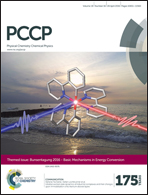Structure and reorientational dynamics of 1-F-adamantane†
Abstract
The polymorphism and the dynamics of a simple rigid molecule (1-fluoro-adamantane) have been studied by means of X-ray powder diffraction and broadband dielectric spectroscopy. At temperatures below the melting point, the molecule forms an orientationally disordered Phase I with a cubic-centered structure (Phase I, Fm![[3 with combining macron]](https://www.rsc.org/images/entities/char_0033_0304.gif) m, Z = 4). This phase possesses eight equilibrium positions for the fluorine atom, with equal occupancy factors of 1/8. A solid–solid phase transition to a low-temperature tetragonal phase (Phase II, P
m, Z = 4). This phase possesses eight equilibrium positions for the fluorine atom, with equal occupancy factors of 1/8. A solid–solid phase transition to a low-temperature tetragonal phase (Phase II, P![[4 with combining macron]](https://www.rsc.org/images/entities/char_0034_0304.gif) 21c, Z = 2) reduces the statistical disorder to only four possible equivalent sites for the fluorine atom, with fractional occupancies of 1/4. The dynamics has been rationalized under the constraints imposed by the space group of the crystal structure determined by powder X-ray diffraction. The dielectric spectroscopy study reveals that the statistical disorder in Phase II is dynamic in character and is associated with reorientational jumps along the two- and three-fold axes. In the dielectric loss spectra, the cooperative (α) relaxation exhibits a shoulder on the high-frequency side. This remarkable finding clearly reveals the existence of two intrinsic reorientational processes associated with the exchange of the F atom along the four sites. In addition to such “bimodal” relaxation, a secondary Johari–Goldstein relaxation is detected at lower temperatures.
21c, Z = 2) reduces the statistical disorder to only four possible equivalent sites for the fluorine atom, with fractional occupancies of 1/4. The dynamics has been rationalized under the constraints imposed by the space group of the crystal structure determined by powder X-ray diffraction. The dielectric spectroscopy study reveals that the statistical disorder in Phase II is dynamic in character and is associated with reorientational jumps along the two- and three-fold axes. In the dielectric loss spectra, the cooperative (α) relaxation exhibits a shoulder on the high-frequency side. This remarkable finding clearly reveals the existence of two intrinsic reorientational processes associated with the exchange of the F atom along the four sites. In addition to such “bimodal” relaxation, a secondary Johari–Goldstein relaxation is detected at lower temperatures.


 Please wait while we load your content...
Please wait while we load your content...